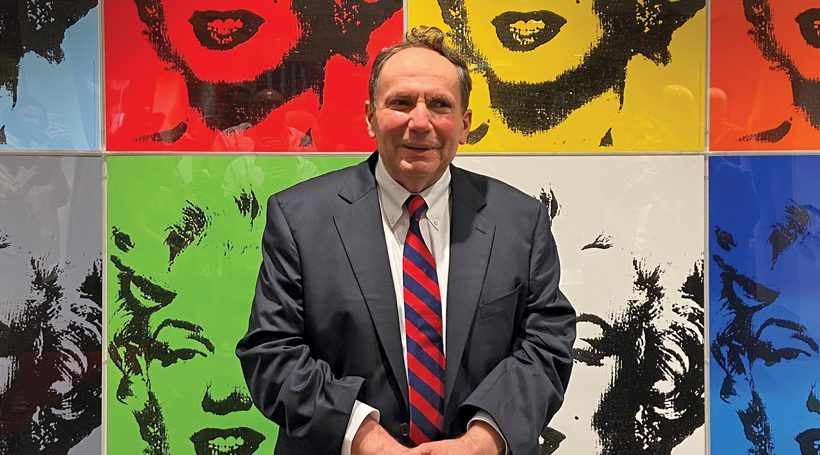Gregory McCoy with 8 of his 323 Marilyn Monroe posters
The moment he set his eyes on an Andy Warhol painting years ago at a South Jersey gallery, Moorestown resident Gregory McCoy decided he was going to become an art collector. It was love at first sight for the then 30-year-old graphic designer – but it would take 6 more years before he was able to scrape together enough money to purchase his first piece.
 In the decades that followed, McCoy made up for lost time. He has built his collection of Warhol works and memorabilia by buying and selling pieces, which have appreciated in value exponentially over time. It was a slow and steady pursuit until one day about a dozen years ago, McCoy hit his version of a jackpot.
In the decades that followed, McCoy made up for lost time. He has built his collection of Warhol works and memorabilia by buying and selling pieces, which have appreciated in value exponentially over time. It was a slow and steady pursuit until one day about a dozen years ago, McCoy hit his version of a jackpot.
While browsing art online, he found 4 undiscovered screen prints of Marilyn Monroe in Warhol’s signature style. The seller was a dealer of rare books and art in Sweden. And although there was no way to verify that the pop artist was involved in their production, McCoy instantly knew these Marilyns were something special and collecting them would be a rare opportunity.
Knowing that Warhol was famous for mass producing large screenprints of famous people, McCoy suspected that there were many more. He was eager to find out why they were created and how involved, if at all, Warhol was. These were the questions that led him on an all-consuming quest: To track down and buy as many of these Marilyns as he could find and then research their origins. To date the tally is 323. As for whether or not Warhol was involved in making the prints – or if he even knew about them – well that’s still an open question.
It’s a puzzle that has intrigued more than just McCoy. His quest, and the collection, were recently the subject of a major art exhibit in Philadelphia entitled “Out of Sight: An Art Collector, a Discovery and Andy Warhol,” featuring 18 of McCoy’s never-before-exhibited Marilyns. Also, 2 books published last month examine his collection, with art critics weighing in on whether or not Warhol was involved in their production – or even if that matters when weighing their art-world worth.
While McCoy is enjoying his 15 minutes of fame – which Warhol famously predicted everyone in the world would experience – he’s hoping the attention will help him learn more about his collection.
Both the book and the exhibit – which was the main attraction of Warhol@Penn Again, a series of exhibitions and special events to commemorate Penn’s 1965 Warhol exhibit – makes a case for the artist’s connection to the prints.
When he first saw the screenprints, McCoy immediately recognized the striking similarity to Warhol’s 1962 screenprint of Monroe, “Twenty-five Marilyns in Black and White,” owned by the Stockholm, Sweden-based Moderna Museet, the first European museum to have a major Warhol exhibit in 1968.
The Marilyns may look like typical Warhol posters widely for sale, but McCoy’s love of Warhol led him to suspect that they were special, says Maureen McCormick, the Director of Registration at Atelier Fine Art Services – where McCoy’s collection is housed.
“Most collectors would have seen the first print, thought it was interesting and moved on,” says McCormick. “It’s the fact that Gregory has been such a fan of Warhol for so many years and is obsessive – in the nicest sense of the word – that he was able to recognize it might have had something to do with that show in 1968.”

Memorabilia from McCoy’s collection
McCoy knew that the Moderna director and Warhol had been friends for years before the 1968 exhibit, and the 2 shared a passion for art that could be produced without the involvement of an artist. Warhol was known for using stencils to transfer famous images to canvases that could then be mass produced.
Working with the Swedish book collector, McCoy found most of the other Marilyns in his collection through Swedes who had some connection with the Moderna Museet in the late 1960s. His working theory is that the posters were created for the Stockholm exhibit, either to be displayed outside of the Museum, used as wallpaper inside the museum or to be sold in the gift shop. For still unknown reasons, any plans to use these Marilyns by the museum were scrapped.
McCormick says she suspects there were even more reproductions of the mysterious Marilyns than the hundreds McCoy purchased, but it’s hard to say without more information about their origins. Although it’s not the first time McCoy has exhibited his Warhol collection – that was in 2014 in Moorestown – he says the purpose of showing the work is not just to let others see and appreciate the art he loves. He’s hopeful the collection and the catalog could lead to more information about the production of his treasured screenprints, which would help McCoy conclusively solve the art-world puzzle.
But that may be wishful thinking, says McCormick. Although she does suspect Warhol had to at least have known about the Marilyns, so far no one has found a paper trail to conclusively link the artist to the art. Also, Warhol died in 1987 without talking publicly about the specific screenprints.
“No one has found that smoking gun – a transcribed message from Warhol saying ‘Make these things’ or even ‘Ok, I love the idea,’” McCormick says. “So, of course, that’s the hope, that the exhibition catalog may bring some evidence.”
If it happens, she adds, it will be thanks to McCoy. “Gregory’s obsessiveness,” she says, “probably saved these Marilyns from oblivion.”














